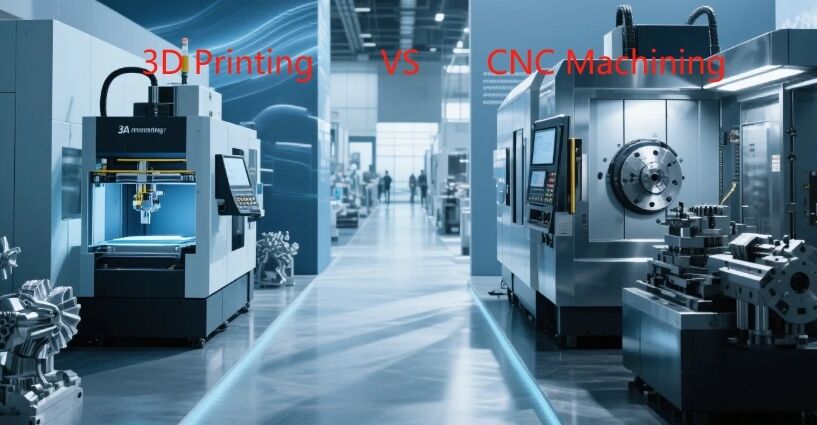9. mája 2025 | Trendy v technológiách výroby
V oblasti výroby sú tlačové 3D tlačenie kovu a CNC frézovanie ako dva vrcholní hráči, každý s jedinečnou "sadou zručností" na boj o prednosť. Niektorí tvrdia, že 3D tlač je budúcim hviezdou, ktorá prerušuje tradície, zatiaľ čo iní veria, že CNC frézovanie stále zostáva nezlomiteľným "starším bratom". Kto vyhrá za týmto technickým hromadiskom? Alebo môže byť odpoveď zložitejšia, ako si myslíme.
1. Porovnanie súčasného stavu: Keď sa "pridávanie" stretnie so "odoberaním"
Hlavný rozdiel medzi 3D tlačou kovu (additívne výrobné technológie) a CNC frézovaním (subtraktívne výrobné technológie) spočíva v "naskladňovaní materiálu" alebo "rezaní materiálu".
- 3D tlač: naskladňovanie vrstiev kovového prášku alebo drôtu vrstica po vrstici ako stavebné bloky, vhodné pre komplexné štruktúry (ako interne dutiny, špeciálne tvarované povrchy) a personalizované prispôsobenie, s využitím materiálu viac ako 95 %. Napríklad záväznik z titánovej aliancie Honor Magic V2 je vyhotovený 3D tlačou, čo ušetrí materiál a dosahuje lehkú hmotnosť.
- CNC spracovanie: "vyfrézovanie" dielcov z celekovej časti materiálu pomocou rezačných, frézovacích a iných procesov, s presnosťou na úrovni nanometrov a povrchom blízkym zrkadlovému efektu, čo je osobitne vhodné pre hromadnú výrobu. Rám z titánovej aliancie Apple iPhone 15 Pro je reprezentatívnym dielom CNC technológie.
Kľúčové porovnanie údajov:
|
Index |
Metal 3d printing |
CNC spracovanie |
|
Presnosť |
±0.1mm |
0,1-10 μm (ultra presná úroveň) |
|
Hrubiadosť povrchu |
Ra2-10μm |
Ra0,1μm alebo menej |
|
Účinnosť využitia materiálu |
>95% |
Nízka (vyžaduje sa odstránenie odpadu) |
|
Aplikačné scenáre |
Komplexná štruktúra, malo sériové prispôsobenie |
Vysoká presnosť, hromadná výroba |
2. Výhody a problémy: „kopí a štít“ technológie
Tajný kód rastu 3D tlači na kov:
- Sloboda dizajnu: Dokáže vyrábať zložité geometrické tvary, ktoré nie sú možné dosiahnuť pomocou tradičných procesov, ako sú lehké komponenty leteckých motorov.
- Rýchla iterácia: Není potrebné otvárať formy, prototypy sa vytvárajú priamo cez digitálne modely, čo významne skrátia cyklus vývoja.
- Inovácia materiálov: Podporuje ťažko spracovateľné materiály, ako sú titanové ligatúry a niklové vysokoteplotné ligatúry, ale voľbateľné materiály sú stále obmedzené (ako obmedzený počet druhov kovových práškov).
Nahraditeľnosť CNC obrábania:
- Extrémna presnosť: CNC je stále prvou voľbou v oblastiach, ktoré vyžadujú striktnú presnosť na úrovni mikrometrov, ako sú medicínske implantáty alebo komponenty polovodičov.
- Škálovateľná cena: V hromadnej výrobe je jednotková cena CNC oveľa nižšia než pri 3D tlači a je stabilnejšia.
- Univerzálne využitie materiálov: Podporuje takmer všetky kovové a nekovové materiály, od aluminióvych ligatúr po inžinierske plastiky.
Bežné výzvy:
- tlač 3D: Vysoká hrubosť povrchu (vyžaduje ďalšie úpravy), drahé náklady na vybavenie a pomalá rýchlosť.
- Frezovanie CNC: Zložité štruktúry vyžadujú viacero procesov, veľa odpadu materiálu a veľké poškodenie nástrojov pri frezovaní tvrdoch materiálov ako sú titanové ligatúry.
3. Aplikačné oddelenie: Ktoré z týchto je lepšie vhodné pre vaše potreby?
Prípady použitia 3D tlače:
- Medicínska prispôsobenie: ako ortopedické implantáty, ktoré dokonca dokonale zapadajú do kostnej štruktúry pacienta.
- Letecká technika: Komponenty so znižovanou hmotnosťou a integrovaným dizajnom (ako napríklad vetracie lopatky s internými chladnými kanálmi).
- Výroba malých sérií: Uniká náklady na formy a rýchlo overíte dizajn.
Prípady voľby CNC spracovania:
- Spotrebiteľské elektronické zariadenia: Produkty v veľkom objeme vyžadujúce vysokú kvalitu povrchu, ako rámik mobilného telefónu a obaly notebookov.
- Výroba automobilov: Štandardizované komponenty, ako sú bloky valcov motoru a časti prevodoviek.
- Nástroje s vysokou presnosťou: Presné formy, časti optických nástrojov atď.
4. Budúce trendy: Fúzia alebo náhrada?
V krátkom horizonte budú obe spolupracovať a dopĺňať sa, ale technologické postupy môžu prepsať pravidlá hry:
Evolučný smer 3D tlače:
- Prelom v rýchlosti a nákladoch: Napríklad Seuratova „regionálna tlačová technológia“ získa väčšie plochy prášku naraz cez pulzné lasery, čo zvýši rýchlosť viac než o 3 krát.
- Hybridné výrobné postupy: Kombinujte CNC ďalšiu úpravu na vylepšenie povrchovej kórie. Napríklad technológia EHLA 3D Fraunhofer Institute kombinuje vysokú efektívnosť laserovej nanesovacej technológie s presnosťou prísľubnej metódy pylového ložiska.
Cesta k upgradu CNC:
- Inteligencia a automatizácia: Optimalizujte nástrojové trasy pomocou umelej inteligencie, znížte manuálny zásah a ešte viac znížte náklady.
- Viackoordinatné spojenie: Štyri- a sedem-koordinatové stroje spĺňajú vyššie požiadavky na komplexnejšiu štruktúru.
Predpoveď pre priemysel: Do roku 2030 môže veľkosť trhu s kovovým 3D tlačením presiahnuť 30 miliárd USD, ale CNC stále bude zastupovať viac ako 60 % podielu v presnej výrobe.
Není žiadny víťaz, len najlepšia kombinácia
Král budúcej výrobnnej industrií nemusí byť jediná technológia, ale spolupracujúci ekosystém „3D tlač + CNC“. 3D tlač sa stará o prekonanie dizajnových obmedzení, CNC zabezpečuje presnosť a efektivitu, a integrácia oboch (ako hybridného zariadenia s aditívnymi a subtraktívnymi metódami) sa stane novým štandardom pre vysokošíľové výrobu. Ako povedal jeden inžinier: „Použite 3D tlač na vytvorenie nemožných tvarov a potom použite CNC na vyhladenie dokonalého povrchu – toto je konečná odpoveď na výrobu.“


